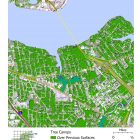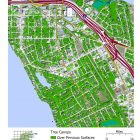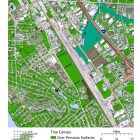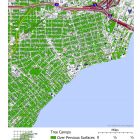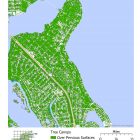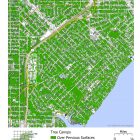Study suggests green infrastructure may solve city problems
Posted on April 1, 2019 By Editor Articles, Brooklyn, Downtown, Springfield, Neighborhood News, Riverside, Avondale, Ortega, Murray Hill, San Jose, San Marco, St. Nicholas, Top Stories
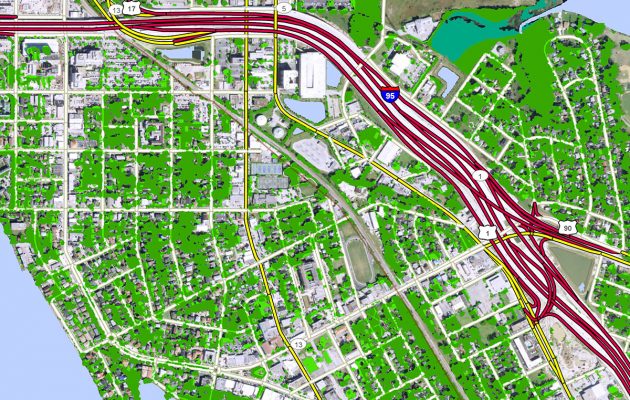
One way to improve Jacksonville’s problems with stormwater flooding, crime, air pollution, job creation and mental health is simple – plant more trees, said Karen Firehock.
As executive director of Green Infrastructure Center, a nonprofit based in Charlottesville, Virginia, Firehock and her team have been conducting a federally-funded independent review of Jacksonville’s urban canopy and its effect on stormwater and water quality.

During the second of three public meetings, which was sponsored by the San Marco Preservation Society and held in Preservation Hall February 28, Firehock explained how her organization is helping the City of Jacksonville map, evaluate and restore its urban forest while focusing on stormwater management. Jacksonville is one of 12 southern cities to be part of the study, which is funded by the United States Forest Service.
During the meeting, which was sparsely attended, Firehock discussed specific ways the City can beef up its green infrastructure. At the end of the study, the nonprofit will provide the City with an online casebook, which Jacksonville residents can access with its recommendations and findings. The Green Infrastructure Center held its third and final meeting March 28 in Springfield.
“We want cities to understand that trees, wetlands, streams, and rivers are part of the cities’ infrastructure, and we need to manage them just like we manage our built assets,” she said, noting that “gray” infrastructure is comprised of sidewalks, roadways, pipes, and buildings. Jacksonville Urban Forester Richard Leon agreed. “We are looking at how urban trees affect our city’s water quality, and how we can incorporate trees, so they are looked at as infrastructure and not just as a commodity,” he said before the meeting.
Forty-two percent of Duval County is covered with trees, although they are not evenly distributed. Having a healthy urban tree canopy is very beneficial. Not only do trees soak up stormwater – a single tree, depending on species and size, can soak up between 760 and 4,000 gallons of water per year – they provide “access to fitness,” clean the air, improve mental health, reduce crime, lower residential vacancy rates, encourage people to shop more, and attract small companies to cities,” Firehock said.
“Trees pick up particulate matter and clean the air. If you have a well-treed neighborhood, you are going to have better air quality than one that doesn’t have many trees. Trees improve mental health. We heal better when we see green. Less crime occurs in neighborhoods with lots of trees. Statistically, it is proven the more treed the area, the lower the crime rate,” she said, also adding that people shop longer and pay more per item with they visit tree-lined shopping districts. “It makes sense to spend money on trees and plant them right. You’ll get it back in property taxes and sales taxes. The trees will pay the city back.”
Although nearly half of Jacksonville is covered in trees, only 12 percent of Downtown has an adequate urban canopy. “We need to change our land cover so that water can better infiltrate,” she said, noting trees planted in open spaces soak up more liquid than those hemmed in by impervious sidewalks.
“Cities are tending to lose their trees to development and storms. We are not planting them fast enough,” she said.
Because most of the City’s land is not publicly owned, it is necessary to work with businesses, neighborhood associations and private property owners to get the required result. The Green Infrastructure study analyzed the canopy within each watershed by dividing the City into one-meter by one-meter squares to see how the trees are “sitting,” and analyzing every street in Jacksonville to determine how shady it is. “A conservative estimate is to have 20 percent of the street covered by shade,” she said.
During the meeting, Firehock made several recommendations to how Jacksonville residents can improve their urban canopy.
Trees in construction areas must be protected by placing a strong metal fence around them to guard against root damage. “Currently Jacksonville requires a fence be erected six feet away from the base of the tree,” she said. “Best practices suggest going to the edge of the tree, called the drip line, and then going off another half so if you park a backhoe it will not smush down the roots.”
The average urban tree only lives approximately nine years because it is not planted with enough space to spread its roots. Firehock recommends the City consider how much “volume” it gives its trees when they are planted.
She also recommends city officials do a land-cover assessment every four years, as well as draw up an urban forest management plan to ensure their financial and staff resources are being used wisely. Also, an emergency response plan should be created to chart the risk of different trees within city limits. “You can reduce risk tremendously with an assessment,” she said. “If a storm comes through and you lose a lot of trees, with the assessment you’ll know where your trees were. If you call it green infrastructure, you can get money from FEMA to put your trees back.”
Firehock also suggested the City consider shrinking its development footprint to leave more vegetation when it approves new developments and that it reconsider its parking standards, as to not build lots the size to accommodate Black Friday shoppers. “There is technology that can be used – reinforced grass people can park on,” she said, adding existing parking lots can be jackhammered so trees can be planted. “Pavement lasts longer when it is shaded,” she said.
By Marcia Hodgson
Resident Community News




 (1 votes, average: 5.00 out of 5)
(1 votes, average: 5.00 out of 5)


